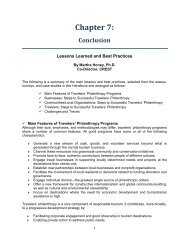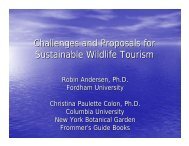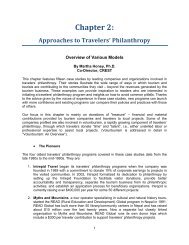Travelers' Philanthropy Handbook - Center for Responsible Travel
Travelers' Philanthropy Handbook - Center for Responsible Travel
Travelers' Philanthropy Handbook - Center for Responsible Travel
You also want an ePaper? Increase the reach of your titles
YUMPU automatically turns print PDFs into web optimized ePapers that Google loves.
organization try to drive the change. The power of ecotourism lies in the good intentions ofmillions of travelers and in satisfaction they get from being a positive <strong>for</strong>ce. The traveler’s urgeto do good gives ecotourism the power to grow spontaneously through contagious socialresponsibility, rather than by rules and regulations and policies. They too have their place, butare better at fine tuning than shaping consumer behavior.A few decades into this great experiment, has ecotourism succeeded? The answer is directlyrelevant to travelers’ philanthropy. If ecotourism hasn’t succeeded, why should travelers’philanthropy do any better? If it has, what can travelers’ philanthropy add to ecotourism? 35 Onbalance, ecotourism has become a reality with recognized principles and practices. It has alsoovercome the perception of being a green marketing tool of the tourism industry. Andecotourism principles and practices have now become a positive <strong>for</strong>ce <strong>for</strong> development and arehelping to move the tourism industry towards sustainability.• From Ecotourism to <strong>Travel</strong>ers’ <strong>Philanthropy</strong> in KenyaIn the following example, I show how ecotourism has begun to open the door to travelers’philanthropy by creating the enabling environment, institutions, and governance needed <strong>for</strong>successful community-based conservation.East Africa has the richest biota on earth,one that has coexisted with pastoralpeoples <strong>for</strong> millennia and humankind sinceour emergence in the savannas. Here weface the awesome task of conservingwildlife in the face of rapid populationgrowth, poverty, and development. Howcan responsible tourism promptcommunities to conserve wildlife <strong>for</strong> theirown advantage, rather than depend onoutside conservationists and donors?In the early 1990’s, Kenya had no legallyconstituted wildlife associations throughwhich local communities could have avoice in wildlife management policies.Good-willed visitors and a few touroperators spent years struggling againstCommunity Resource Assessors, Kenya.Credit: David Westernlocal suspicion, tussles and jealousies, trying to develop tourism on community lands. Localleaders filched money and gave jobs to relatives. Tourist revenues became a source of conflictand corruption. Then the Kenya Wildlife Service (KWS), under its Community Wildlife Service,helped <strong>for</strong>m wildlife associations. Legalizing these associations gave communities a voice andway <strong>for</strong>ward through a representative body, the National Wildlife Forum (NWF). Theassociations and NWF, with KWS backing, overcame <strong>for</strong>midable government opposition to thewildlife associations and promoted community participation in the tourism industry. Associationsenabled communities to raise conservation and development funds, set up conservancies, andtrain members in the business and conservation skills. These activities spurred collaboration,35 For an overview and review of ecotourism see Martha Honey, Ecotourism and Sustainable Development: Who Owns Paradise?,2 nd edition (Washington, DC: Island Press, 2008).15















